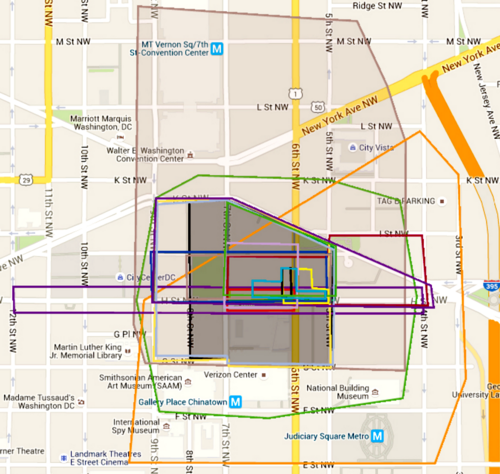Not everyone agrees on where DC’s Chinatown is
While DC’s Chinatown officially spans roughly two square blocks in the city’s central downtown area, a number of long-time residents have different ideas of the neighborhood’s boundaries. This map shows how “Chinatown” means different things to different people.

The lines on the map represent 17 different definitions of where Chinatown begins and ends, along with DC’s official boundaries. Map by Molly Carpenter, Pranita Rahbhise, Katy June-Friesen, and Dr. Willow Lung-Amam.
The map is part of a larger recent project by graduate students at the University of Maryland who wanted to better understand the rapid changes to the neighborhood and what they have meant for those in the Chinese American community with long term connections to it.
The researchers conducted 16 interviews with people who have long-term connections to Chinatown, either because they live there or are involved in the neighborhood through business and cultural organizations. They also interviewed eight people they met on the street or in restaurants or coffee shops. They asked those they spoke with to draw their own map of Chinatown and identify the places that were important to them.
While some identified Chinatown as a narrow strip of shops and restaurants along H Street, others saw the neighborhood as stretching from E Street to M Street. Meanwhile, others saw Chinatown as part of the larger Gallery Place or Penn Quarter neighborhoods.
Those more familiar with the neighborhood tended to see Chinatown as a shrinking span of restaurants along H Street NW, while newcomers or visitors tended to point to the Verizon Center and Gallery Place as the defining features of the neighborhood. And while many interviewed acknowledged that Chinatown has been shrinking, others recognized that the community has also spread out to the suburbs and is not dying.
Katy June-Friesen, one of the researchers, offered her take on why the people she interviewed had such varying definitions of Chinatown:
I think the way people understand the space, the neighborhood, depends on how they use and experience it. So for some elderly residents of Wah Luck House who speak little English, the neighborhood feels like it is shrinking, because there are fewer services and shops for them, such as a Chinese-speaking doctor or Chinese grocery store. Others (of Chinese background) who have long-term connections to Chinatown but don’t live there may feel the place is more symbolic of history, culture, and traditions, but the boundaries or size of the neighborhood itself don’t matter as much. A restaurant worker might think of Chinatown as just the strip of Chinese restaurants on H Street, while a non-Chinese newcomer to the area might not frequent those restaurants and might think of the neighborhood as “Gallery Place” or something other than “Chinatown.”
Chinatown used to be in a different place, and it has seen a lot of change
First established in the 1880s at Pennsylvania Avenue and 5th Street NW, DC’s first Chinatown was displaced in the 1930s by the Federal Triangle complex. As a result, Chinese immigrants began to settle in today’s location.
In this new location, the community continued to grow through the mid-1960s, establishing schools, clubs, and other community organizations. However, by the mid-1960s, the population of the community began to decline, with many residents moving to the suburbs. Despite this decline, the population of Chinatown was 3,000 in 1970.
In subsequent years, the neighborhood has been the site of a number of revitalization efforts, including the construction of the Gallery Place Metro station and a new convention center (not to be confused with the current convention center), the establishment of a downtown historic zone, which includes Chinatown, as well as the later construction of the Verizon Center.
Recent years have seen changes to the neighborhood accelerate with the continued loss of Chinese residents and businesses. Much of this has been attributed to neighborhood affordability and buyout offers for local residents and business owners as part of a broader trend of redevelopment in the city.
Today, most of Chinatown’s approximately 300 Chinese-American residents live in Wah Luck House and Museum Square, two subsidized housing complexes in the neighborhood.
Despite the diverse views of what constitutes Chinatown, all those interviewed expressed concern about keeping alive what the neighborhood means to them, namely Chinese culture and traditions.
